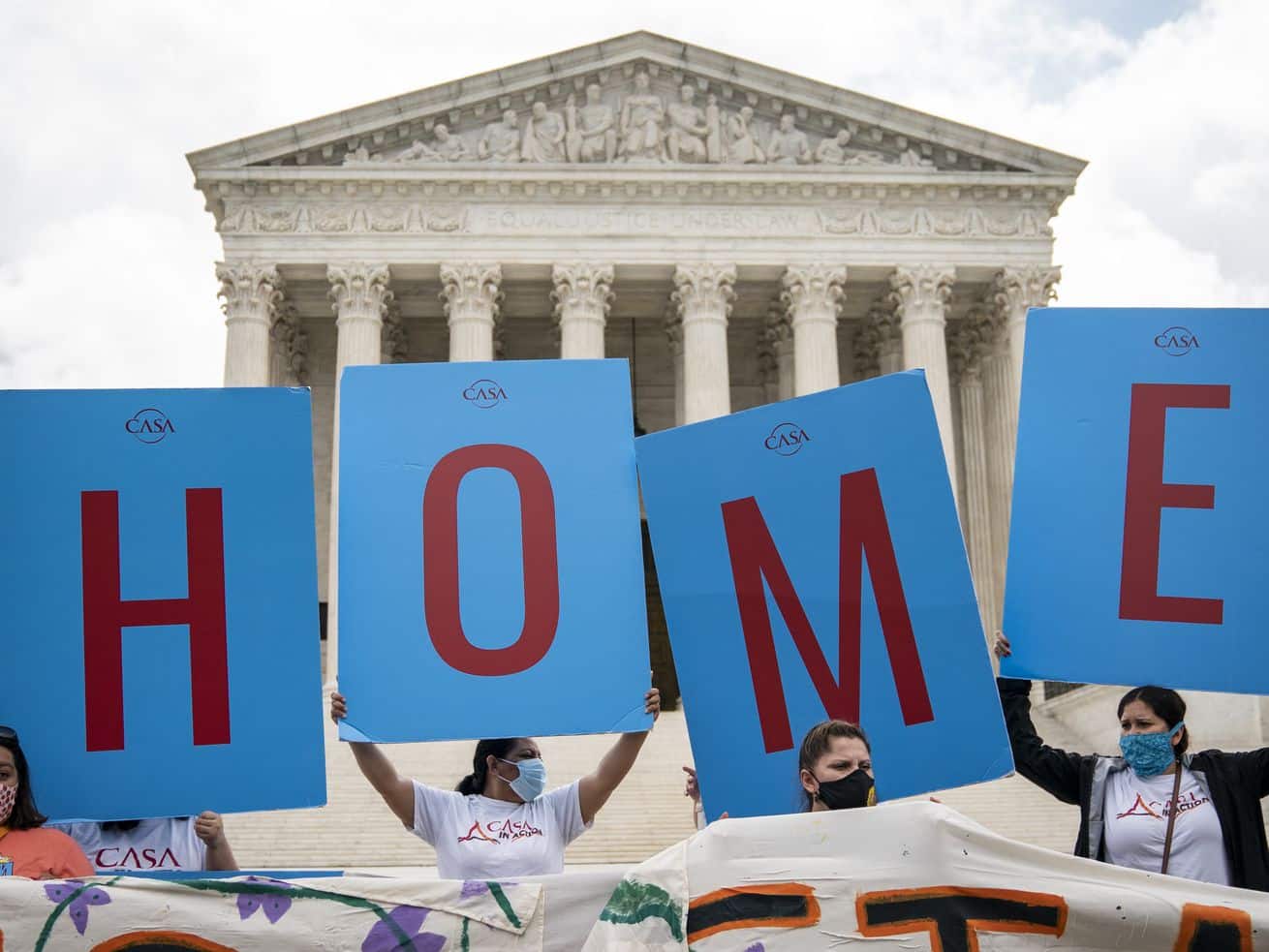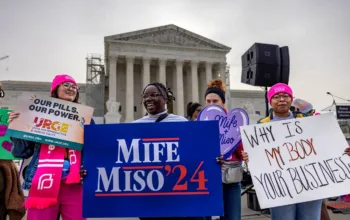The decision halts DHS’s ability to accept new DACA applicants.
On Friday, a federal judge in Texas blocked an Obama-era program protecting undocumented immigrants who arrived in the US as children from deportation, halting the program’s ability to accept new applicants and once again throwing the lives of more than 600,000 people into tumult.
In his 77-page opinion, district court Judge Andrew Hanen concluded that the Deferred Action for Childhood Arrivals program, or DACA, is unlawful because it violates the Administrative Procedure Act, which governs federal rulemaking, by evading the normal “notice and comment” process in adopting new rules.
Hanen’s decision doesn’t immediately affect the 616,030 people, often known as DREAMers, who are currently protected under DACA — but it does mean that the Department of Homeland Security can no longer approve new DACA applications or grant applicants the protections DACA provides.
Just in: A federal judge in Texas has blocked the DACA program going forward — it won’t affect current recipients for now (judge is putting that issue on hold, pending expected appeals), but it blocks DHS from approving new applications https://t.co/urJh8jnJDd pic.twitter.com/LqvSDWx2ao
— Zoe Tillman (@ZoeTillman) July 16, 2021
Hanen also emphasized Friday that “neither this order nor the accompanying injunction requires DHS or the Department of Justice to take any immigration, deportation, or criminal action against any DACA recipient, applicant, or any other individual that it would not otherwise take.”
DACA not only protects undocumented immigrants who came to the US as children from deportation, but allows them to work in the US. DACA protections are renewable and valid for two years at a time.
A coalition of nine states, led by Texas, filed the lawsuit challenging DACA’s legality in 2018, according to the Mexican American Legal Defense and Educational Fund, or MALDEF.
Currently, some 81,000 first-time DACA applications are pending with US Citizenship and Immigration Services as of the end of June, according to CBS News. All of those applicants, however, are now in limbo following Hanen’s decision and pending appeals.
As Vox’s Ian Millhiser explained in December, the Trump administration previously curtailed DACA in an earlier, failed attempt to end it outright, and new applications surged after it was fully reinstated in December — though USCIS has been slow to process the new influx of applicants, resulting in the current backlog.
The Texas ruling has already been met with condemnations from the White House, immigrants’ rights groups, and Democrats in Congress.
Terrible decision on DACA by a federal judge in Texas.
The dreams of hundreds of thousands of young people who are contributing to the American economy will be put on hold for no good reason.
Congress must pass a pathway to citizenship this year. We can’t wait.
— Joaquin Castro (@JoaquinCastrotx) July 16, 2021
In a statement Friday, the Home Is Here Coalition, which includes immigrant advocacy groups like United We Dream, described Hanen’s decision as “cruel and malicious.”
“This decision is a reminder that DACA has never been enough to protect immigrant communities who continue to be at risk of deportation,” the group said.
The Biden administration has already promised to appeal Friday’s decision and reiterated that DHS “plans to issue a proposed rule concerning DACA in the near future.”
President Joe Biden also called for a “permanent solution” for DREAMers in a statement released by the White House on Saturday.
Biden says DOJ will appeal yesterday’s court decision to block new DACA applications pic.twitter.com/y2kvQmu7VO
— Seung Min Kim (@seungminkim) July 17, 2021
“I have repeatedly called on Congress to pass the American Dream and Promise Act, and I now renew that call with the greatest urgency,” Biden said. “It is my fervent hope that through reconciliation or other means, Congress will finally provide security to all Dreamers, who have lived too long in fear.”
If signed into law, the American Dream and Promise Act, which passed the House earlier this year, would provide “conditional permanent resident status” for several categories of immigrants, including DREAMers and Temporary Protected Status beneficiaries, putting them on the path to citizenship.
DACA’s existence has always been tenuous
For many, Friday’s DACA ruling doesn’t come as much of a surprise. Hanen, a George W. Bush appointee who has been described as possibly “the most anti-immigrant judge in the United States,” has made his feelings on DACA clear well before Friday’s ruling. In 2018, he opined that, “if the nation truly wants a DACA program, it is up to Congress to say so” — and even aside from Hanen’s particular feelings, DACA has been under attack virtually since its inception in 2012.
IMMIGRATION FRIDAY BAD NEWS ALERT
Judge Hanen has issued his long-expected decision striking down DACA, ordering the Biden administration to stop approving any new applications. This is the terrible outcome that we unfortunately expected for months. https://t.co/WTMYZsM0WC
— Aaron Reichlin-Melnick (@ReichlinMelnick) July 16, 2021
As former Vox senior correspondent Dara Lind has explained, DACA has its origins during Congress’ failure in 2010 to pass the DREAM Act, which would have created a pathway to citizenship for immigrants who entered the US illegally as children.
Despite failing in the Senate, the DREAM Act gave a name to those immigrants — DREAMers — and after its 2010 defeat, President Barack Obama attempted to address their plight via executive authority.
Obama claimed that the immigrants who would be eligible for legalization under it weren’t being deported anyway, since his administration was targeting “high-priority” immigrants (like those with criminal records) rather than “low-priority” immigrants who’d lived quietly in the US for years. But federal immigration agents were still deporting “low-priority” immigrants, including DREAMers.
So in summer 2012, rather than relying on Immigration and Customs Enforcement agents to protect immigrants by declining to deport them, the administration decided to allow DREAMers to apply for protection from deportation themselves.
In June 2012, President Obama announced the Deferred Action for Childhood Arrivals program. It allowed young unauthorized immigrants who meet certain criteria to apply for a commitment from the federal government for “deferred action” — that is, a commitment not to initiate deportation proceedings — for two years. Successful applicants also received a work permit.
Subsequent attempts to expand the program during the Obama administration were blocked, however, and President Donald Trump launched a renewed assault on DACA upon taking office.
The Trump administration moved to end DACA outright in September 2017, but ran afoul of the Administrative Procedure Act — the same statute Hanen ruled DACA itself to be in violation of on Friday.
In a June 2020 decision, Department of Homeland Security v. Regents of the University of California, the Supreme Court concluded that the Trump administration’s decision to end DACA failed to consider the interests of the more than 600,000 people affected by the change and thus was “arbitrary and capricious” and a violation of the APA. Still, the Court left the door open for subsequent attempts to end the program.
Following that decision, the Trump administration also moved to stop accepting new DACA applicants and to impose other limits on the program, though those measures were reversed by a federal judge in New York last year.
As a result of the back-and-forth between the courts and the Trump administration, DACA recipients, who have lived their entire adult lives in the US, have long been stuck in an uncertain position — something which many lawmakers were quick to point out after Friday’s decision.
Not a surprise, just a painful reminder that we need to stop relying on temporary immigration fixes.
Congress must seize the moment and any and all opportunities to finally provide a pathway to legalization for millions of undocumented immigrants.https://t.co/iDewNu4wWx
— Senator Bob Menendez (@SenatorMenendez) July 16, 2021
“Not a surprise, just a painful reminder that we need to stop relying on temporary immigration fixes,” Sen. Bob Menendez (D-NJ) said in a tweet Friday. “Congress must seize the moment and any and all opportunities to finally provide a pathway to legalization for millions of undocumented immigrants.”
Congress has tried and failed to find a solution for DREAMers
Menendez is right: Though DACA itself has been subject to years of controversy as a matter of executive authority, it would be relatively straightforward for Congress to provide a permanent legislative fix for the more than 600,000 Dreamers who are currently part of the DACA program (according to the Migration Policy Institute, there are more than 1.3 million people in the US who are potentially eligible for DACA, as of 2020).
However, previous bills to do so have failed to clear the Senate, despite the overwhelming popularity of providing a pathway to citizenship for DREAMers.
According to Pew Research Center polling from June 2020, 74 percent of US adults — including a majority of Republicans and those who lean Republican — support “granting permanent legal status to immigrants who came to the U.S. illegally when they were children.”
Still, the DREAM Act failed in 2010 thanks to the filibuster, despite passing the House and winning majority support in the Senate. And in 2018, four possible DACA fixes all died in the Senate, though three of the four also won at least 50 votes.
Most recently, the American Dream and Promise Act has now passed in the House in two different sessions — first in 2019 and more recently in March this year — but has yet to come to a vote in the Senate, and all but certainly would not survive the filibuster as a standalone bill.
A permanent fix for DREAMers could come in the next reconciliation package
For now, an appeal of Hanen’s Friday decision looks to be the next front in the struggle over DACA. The Biden administration has already pledged to do so, which means the case will likely end up before the 5th Circuit Court of Appeals.
Groups involved in the case, including the Mexican American Legal Defense and Educational Fund, have expressed optimism about future appeals.
“The decision was plainly determined by the judge’s views of many years ago,” MALDEF president and general counsel Thomas A. Saenz said in a statement Friday, “and the decision fails to reconcile important recent developments in the law of standing and of presidential authority; it therefore presents numerous grounds for potentially successful appeal.”
However, it’s by no means a sure thing that DACA will fare any better on appeal. As CNN’s Priscilla Alvarez and Tierney Sneed point out, the 5th Circuit is famously “an extremely conservative appeals court,” while the current US Supreme Court features a 6-3 conservative majority, including “three justices who called the program unlawful in a dissent in a previous case.”
Still, there are other possibilities: In response to a day-one Biden memo, Biden’s DHS has said for months that it is working to shore up DACA with a new rule to “preserve and fortify” the program, which could put it on more solid legal footing going forward.
/cdn.vox-cdn.com/uploads/chorus_asset/file/22723627/1221069339.jpg) SANDY HUFFAKER/AFP via Getty Images
SANDY HUFFAKER/AFP via Getty ImagesDHS reiterated that commitment on Friday in a statement on the Hanen decision: “DHS remains focused on safeguarding DACA, and we will engage the public in a rulemaking process to preserve and fortify DACA,” DHS Secretary Alejandro Mayorkas said.
The most promising avenue for DACA advocates, though, could prove to be Congress, despite the continued existence of filibuster. With the Senate gearing up to push for a sprawling second reconciliation package, many Democrats have suggested that immigration reform — including a path to citizenship for DREAMers, among other potential provisions — could make the cut.
In his statement Saturday, Biden gave the idea a nod, noting that “it is my fervent hope that through reconciliation or other means, Congress will finally provide security to all DREAMers, who have lived too long in fear.”
Under reconciliation, legislation in the form of a budget reconciliation bill can pass the Senate with just 50 votes and no fear of the filibuster — but there are restrictions. As Vox’s Dylan Scott explained in January, “a lot of things” are could potentially be included, but they all must affect federal spending and revenue in some (occasionally tenuous) capacity.
Senate Democrats — whose 50-seat majority, with Vice President Kamala Harris as the tie-breaking vote, gives them exactly enough votes to pass a reconciliation bill along party lines — have already used the reconciliation process once this year, to pass the $1.9 trillion American Rescue Plan. Another, even larger package — focused on a laundry list of priorities dropped from the still-in-the-works bipartisan infrastructure bill — looks to be on the way.
Significantly, the inclusion of a path to citizenship seems to have the support of Sen. Joe Manchin (D-WV), a frequent holdout in the Senate Democratic caucus. However, a permanent fix for DREAMers still needs to survive the Senate parliamentarian to make it into any upcoming reconciliation package, and that appears to be an open question.
The parliamentarian’s role in the reconciliation process, according to Scott, is to determine whether or not the budgetary impact of reconciliation measures, such as a potential path to citizenship, are “incidental” or not — and current rules require that incidental provisions be dropped from the bill.
Despite that fact, some senators — such as California Democrat Alex Padilla — are optimistic, and at least one member of the House, Rep. Jesús “Chuy” García (D-IL), has said that immigration provisions are a must-pass in the next reconciliation package.
“A robust and equitable budget reconciliation deal must include a pathway to citizenship for immigrants,” García said in a statement this month. “We must seize this historic opportunity to bring compassion and dignity to our immigration system and provide the certainty that comes with having the legal status that millions of immigrants and their families deserve.”
Author: Cameron Peters
Read More



